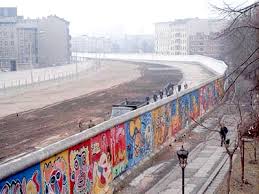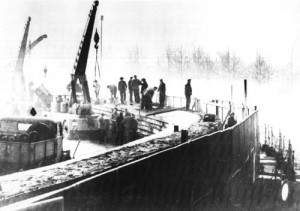Thursday, August 13, 2015
At the end of World War II Germany and its capital city Berlin were divided into quadrants following the provisions of the Potsdam Agreement. Each quadrant was controlled by one of the four Allied powers: the United States, Great Britain, France, and the Soviet Union. During the next two years disagreements escalated between the Soviet Union and the three Western Allies regarding reconstruction plans for post-war Germany.
In 1948 Joseph Stalin instituted a Berlin Blockade that stopped the flow of food, materials, and supplies from entering West Berlin. The Allies countered by airlifting supplies into the city. Stalin finally lifted the blockade in May 1949, but by October of that year, East Germany (German Democratic Republic) and West Germany (Federal Republic of Germany) were established.
The “Inner Border” between East and West Germany remained open until April 1952 when the Soviet Union closed it, erected barbed wire, and stationed armed guards along it to prevent emigration. However, the borders between the eastern and western sections of Berlin remained open and provided a conduit for East Germans who wanted to flee to the west. By 1961 3.5 million East Germans, or 20% of the entire East German population, had left East Germany via Berlin. Among this population were many professionals and young, educated workers. The Soviets had to stop the “brain drain” that sapped its economic vitality.
In the wee hours of Sunday August 13, 1961 the East German army was ordered to close the border in Berlin. They tore up the streets so vehicles could not pass from one side of the city to the other and installed 97 miles of barbed wired entanglements around the three Western sectors. A 12 foot tall concrete wall was constructed within months. The wall included watch towers and no-man’s-land known as the death strip. It was devoid of vegetation but filled with trenches and landmines, which made it impossible for vehicles to cross.
The Berlin Wall stood until November 1989 as a physical manifestation of the Iron Curtain and the Cold War Era. During this period approximately 5,000 people tried to escape over the wall. It is estimated that between 135 to over 200 who tried were killed.
On November 9, 1989, after a series of political changes that liberalized the Eastern Bloc and following weeks of demonstrations, the East German government permitted its citizens to visit West Berlin and West Germany. Crowds of Germans climbed on to the wall and began to hack it apart, but it took bulldozers three years to completely demolish the wall. It took less time to formally reunify the country of Germany. That feat was accomplished on October 3, 1990.
Photos:
Berlin Wall under construction
View of the wall from West Berlin
To commemorate the City of Troy’s 60th Anniversary in 2015, we will publish a different story each day that highlights a person, discovery, or event that occurred locally, regionally, nationally, or even globally between 1955 and 2015 and that helped shape our lives and our community. We will try to post stories on important anniversary dates, but we also realize that dates are less critical than content and context. We will include the facts related to controversial stories, allowing our readers to form their own opinions. We invite you to read and comment on the stories. Your suggestions for topics are also welcome and can be posted on our Facebook page, www.facebook.com/TroyHistoricVillage. You can also email stories or ideas to the 365 Story Editor at ed@thvmail.org.








